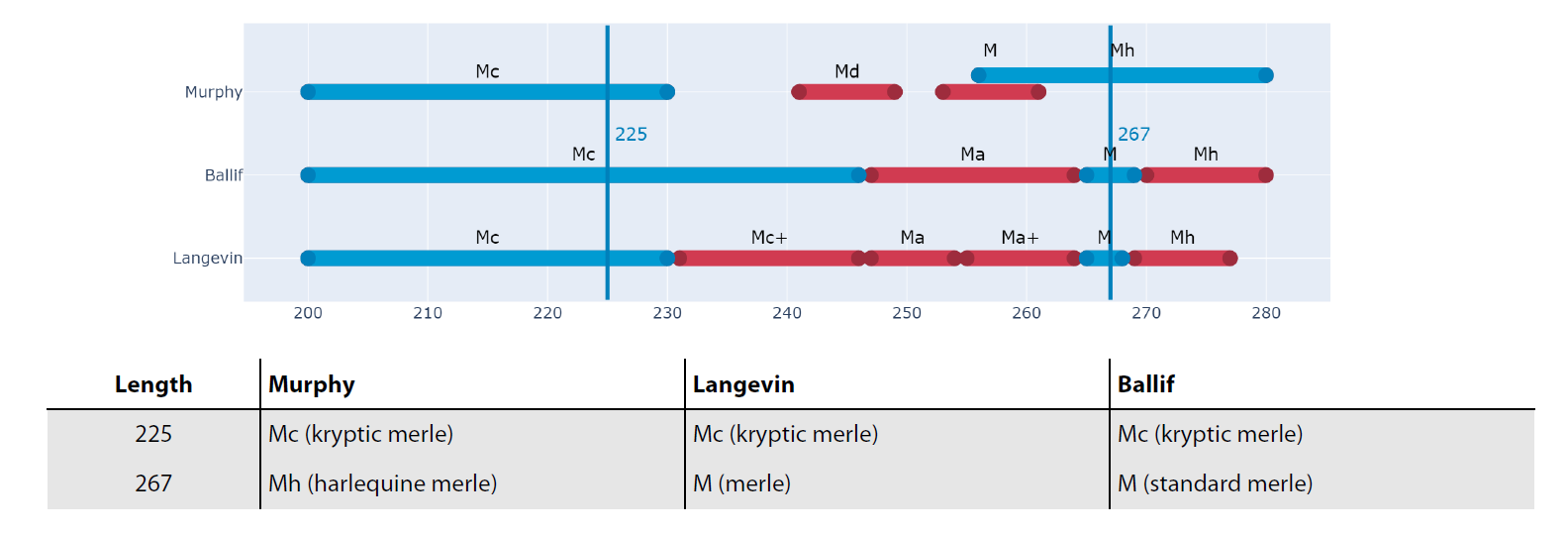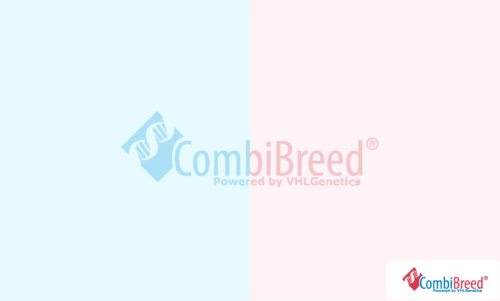M-Locus (Merle) and H-Locus (Harlequin)
Merle pattern in dogs
The merle coat pattern in dogs is caused by a mutation in the PMEL17 gene involving a SINE insertion. This mutation affects eumelanin (dark pigment) but does not impact the production of pheomelanin (red pigment). Dogs with the e/e genotype at the E-locus (recessive red) do not produce black pigment and may carry the merle gene without expressing it phenotypically.
A typical merle coat is characterized by irregularly shaped patches of diluted and solid pigment, often accompanied by blue or partially blue eyes. While the merle gene modifies coat color, it can also cause inner ear malformations that result in deafness. In homozygous merle dogs (M/M), there is an increased likelihood of eye malformations, developmental delays, reduced vitality, or even death before reaching sexual maturity. Consequently, breeding two merle carriers is strongly contraindicated and, in many purebred standards, prohibited due to significant animal welfare concerns.
Length of the SINE insertion
The SINE insertion in the PMEL17 gene contains a variable-length region caused by a repetition of a single nucleotide. The length of this variable region determines the degree of pigment dilution. Based on insertion length, merle patterns are classified as:
- Classic Merle (M)
- Cryptic Merle (Mc)
- Atypical Merle (Ma)
Insertion length also correlates with health risks such as deafness and visual impairments, particularly in homozygous forms.
Genetic basis of the M-Locus (Merle)
Dogs can have the following genotypes at the merle locus:
- N/N (wild-type): No merle-causing insertion.
- Mc (cryptic merle): Genetically merle with minimal to no visible effect.
- Mc+ (cryptic merle+): Transitional form, may exhibit slight merle patterns.
- Ma (atypical merle): Slight coat dilution.
- Ma+ (atypical merle+): Increased dilution, possibly appearing merle-like.
- M (classic merle): Clearly visible merle pattern.
- Mh (harlequin merle): Severe dilution with white patches and higher health risks.
Merle dilutes eumelanin but does not affect pheomelanin, meaning dogs with an e/e genotype (recessive red) at the E-locus do not express the merle pattern. For example, dogs with a black base coat and the merle genotype are called blue merles, while those with a brown or liver base coat (b/b at the B-locus) are known as red merles.
Mosaic Merle
Mosaicism – specifically somatic mosaicism or somatic utation – refers to the presence of two or more types of cells with different genetic makeups in one dog. Merle mosaicism occurs when a mutation (most often a shortening of the merle sequence) happens in a single cell early in embryo development. As the embryo grows, this mutated cell divides and spreads, but the shortened version (allele) ends up only in some of the dog’s cells. Typically, this shortened allele is present in a small number of cells. It’s called the minor allele and is shown in test results inside [square brackets]. The two alleles that show up more strongly in testing (the ones from the parents) are called major alleles and usually have longer base pair numbers.
A dog’s appearance (phenotype) depends on how these mutated cells spread and how many of each type are present. Often, you can’t tell a dog is a Mosaic Merle just by looking at it. But if the mutated cells multiply a lot, the dog’s appearance may be very different from what you’d expect based on its inherited genes.
Health risks
Merle related health problems varies depending on the genotype. Particularly in homozygous forms (double merle) and certain variants (e.g. harlequin merle), impairments occur more frequently. A merle-related high proportion of white on the head is also associated with an increased risk of impairments. In the scientific literature, merle carriers (heterozygous) with health impairments have been described in a few cases and causality to merle have been postulated but not proven.
Genotypes and health risks overview*
| Genotype | Merle expression | Health risk |
|---|---|---|
| N/N | None (wild-type) | No merle-related health risks |
| N/Mc | No visible merle pattern | Very low risk (< 2%) |
| N/Mc+ | Minimal merle traits | Very low risk (< 2%) |
| N/Ma | Slightly visible merle | Low risk (< 5%) |
| N/Ma+ | Common merle pattern | Low risk (< 5%) |
| N/M | Typical merle pattern | Slightly increased risk – Unilateral deafness: < 5 % – Eye anomalies: 5-10 % |
| M/M | Double merle | High risk of deafness and eye problems – Unilateral deafness: 10-15 % – Bilateral deafness: 25-30 % – Eye abnormalities: 50-70 % |
| N/Mh | Harlequin pattern | Moderate risk – Unilateral deafness: 5-10 % – Eye abnormalities: 10-20 % |
| Mh/Mh | Severe harlequin pattern | Very high risk of eye and hearing problems (>70%) |
*Figures have been calculated in limited number of studies and are partially based on small sample numbers. Figures give an indication. The real percentages might be lower or higher.
Genetic tests before breeding
Merle status should also be determined in breeding of known merle-carriers with a non-merle phenotype dog (cryptic or atypical variants). Care should be taken when mating Mc or Ma carriers with M carriers, as new mutations have been reported in the scientific literature in which the inherited variable region of the insertion is extended by a few bases, so that an inherited Mc allele becomes an Mc+. Although these are isolated cases, mating should be avoided from this point of view.
Report of Coat Colour Merle
The CombiBreed report for Coat Colour Merle includes lengths and interpretations of the Merle allele as well as a clear representation based on three literature studaties (Murphy, Ballif and Langelvin).
Below, you’ll find an example of the Merle report. This report has been enhanced with clear explanations for added insight and ease of use. Do you have any questions about the updated report? Feel free to contact us!

In case of mosaicism, the results of the extra cells will be published underneath the regular results. As can be seen in the following image:
Coat colour Merle is part of various packages and is also available as a standalone test with test code H630.
H-Locus (Harlequin)
The Harlequin or H-Locus, which corresponds to the gene PSMB7, is a particular locus that can further affect the coat colour and pattern of a Great Dane with a Merle phenotype. In dogs that also express Merle, the dominant mutation to the H-Locus further modifies the coat colour, resulting in an unpigmented white base with irregular black spots.
The Harlequin mutation is believed to be homozygous lethal, meaning that only wild-type and carriers will be born. This also means that breeding two Harlequin carriers together may result in a smaller than usual litter size.
Relevant tests
- H630
- H316
- H469
-
 H630
H630Coat Colour Merle
- All Breeds
- PMEL
- Integumentary system